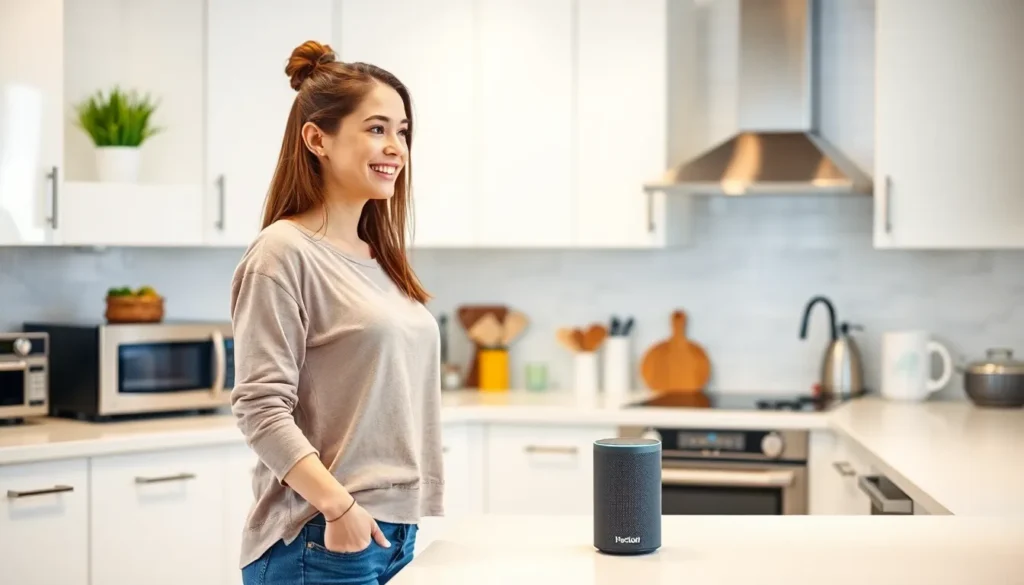Imagine a world where you can turn on the lights, play your favorite tunes, or even order pizza—all with just the sound of your voice. Voice-activated technology is no longer a futuristic dream; it’s here, making everyday tasks easier and adding a sprinkle of magic to daily life. Whether it’s sassy assistants like Siri or the ever-reliable Alexa, these digital companions are ready to respond faster than you can say “Hey Google!”
As voice recognition becomes more sophisticated, it’s transforming how people interact with their devices. Gone are the days of endless button pressing and complicated menus. Instead, users can simply speak their minds and watch their commands come to life. So, if you haven’t yet embraced this tech-savvy revolution, get ready to chat your way into the future—because who wouldn’t want a personal assistant that doesn’t judge their late-night snack choices?
Voice Activated Technology
Voice-activated technology facilitates seamless interaction between users and devices. Users control various tasks using simple voice commands, which streamlines processes like managing smart homes or accessing information quickly. Voice recognition advancements significantly enhance user experience, allowing for more natural conversations with virtual assistants.
Digital assistants like Siri, Alexa, and Google Assistant serve as prime examples of this technology. They understand and interpret commands, performing actions such as setting reminders, adjusting thermostat settings, and even providing weather updates. These assistants utilize machine learning algorithms to recognize speech patterns and improve their accuracy over time.
Accessibility represents another critical aspect of voice-activated technology. Individuals with physical disabilities can navigate devices more easily, enhancing their overall independence. By removing barriers, voice commands create a more inclusive environment for users of all abilities.
Security also benefits from this innovation. Voice recognition systems offer secure access to devices and accounts, utilizing biometric data to identify authorized users. As this technology evolves, it becomes crucial for manufacturers to prioritize user privacy and data protection.
The future of voice-activated technology appears promising. Integration with artificial intelligence enables even more sophisticated interactions and automation capabilities. As households increasingly adopt smart devices, voice recognition is set to become a staple in modern living.
Types of Voice Activated Technology

Voice-activated technology encompasses various tools that enhance user interaction through voice commands. The following categories illustrate the key types of these technologies.
Smart Speakers
Smart speakers serve as central hubs for voice-activated devices. Brands like Amazon Echo and Google Nest utilize built-in voice assistants to respond to user inquiries. Users can control music playback, adjust smart home devices, and even place online orders effortlessly. With features such as multi-room audio and compatibility with various smart home ecosystems, smart speakers offer convenient solutions for daily activities.
Voice Assistants
Voice assistants represent the software component behind voice interaction. Siri, Alexa, and Google Assistant interpret user commands to perform tasks efficiently. These assistants provide quick answers, set reminders, and control compatible smart devices. Machine learning enhances their accuracy over time, allowing them to adapt to individual users’ preferences. Accessible through smartphones and various devices, voice assistants enrich the user experience significantly.
Voice Recognition Software
Voice recognition software enables devices to transcribe spoken language into text. Popular applications include transcription services and command execution for various software. The technology recognizes different accents and dialects, improving communication across diverse user groups. In addition to enhancing productivity, this software increases accessibility for individuals with disabilities. Its growing adoption spans industries such as healthcare, customer service, and education, illustrating the versatility of voice recognition applications.
Benefits of Voice Activated Technology
Voice-activated technology offers numerous advantages that enhance everyday experiences. It provides users with tools that simplify tasks and improve overall efficiency.
Convenience and Accessibility
Voice-activated technology makes life easier for many individuals. Control over smart devices occurs through simple voice commands, allowing hands-free interaction. Users can manage lights and thermostats without moving. Accessibility features support individuals with disabilities, promoting inclusivity. Digital assistants provide quick access to information, reducing barriers to communication for diverse user groups. This technology empowers those who might struggle with traditional input methods, fostering greater independence in daily activities. Many individuals benefit from using this technology for task management and social interactions.
Enhanced Productivity
Productivity sees significant improvement through voice-activated technology. Automating routine tasks frees up time, allowing users to focus on more important activities. Scheduling reminders, sending messages, and making calls can all happen using voice commands. Many professionals utilize digital assistants to streamline workflow, making it easier to juggle multiple responsibilities. Teams also gain an edge by quickly accessing information and resources via voice searches. Increased efficiency leads to better time management and, ultimately, higher output. As voice technology continues to develop, its impact on productivity will grow even further.
Challenges and Limitations
Voice-activated technology faces several challenges and limitations despite its advantages.
Privacy Concerns
Concerns about privacy arise with the use of voice-activated devices. Users often worry about data collection and unauthorized listening. Smart speakers continuously listen for wake words, leading to fears that conversations may be recorded without consent. Many companies implement data encryption and anonymization to address these issues. Public awareness of privacy policies is vital for users to feel secure in their interactions. Users must understand what data is collected and how it is used to mitigate these fears.
Accuracy and Misunderstandings
Voice recognition technology sometimes struggles with accuracy. Different accents and dialects can confuse voice-activated systems, leading to misunderstandings. Background noise also affects performance, causing errors in command execution. Continuous improvements in machine learning help refine accuracy over time, but these systems are not infallible. Users experience frustration when commands are misinterpreted or not executed properly. Additional context and clarifications from users can enhance accuracy, but reliance on voice alone may still present challenges.
Future of Voice Activated Technology
Integration with artificial intelligence holds immense potential for voice-activated technology. It’s expected that enhancements in AI will lead to more natural interactions with devices. As systems learn user preferences, they become more intuitive, further elevating user experience.
Advancements in machine learning contribute significantly to this evolution. They enable voice assistants to better understand various accents and dialects, reducing communication barriers. Continuous updates increase responsiveness and accuracy, enhancing overall effectiveness for users.
Smart homes will likely become even smarter. Integrating voice technology improves not only convenience but also energy efficiency. Users might find it easier to manage their appliances and maintain control over their environments simply through voice commands.
Accessibility remains a key focus. Developers aim to make voice technology inclusive for all individuals, especially those with disabilities. Real-time translations and transcriptions may become standard features, providing seamless communication across different languages.
Privacy measures are continually evolving in response to user concerns. Technologies like data encryption and anonymization help address fears related to unauthorized listening. Engagement with transparent privacy policies fosters trust and encourages widespread adoption of these devices.
Market growth for voice-activated technologies appears robust. Industry analysts predict significant increases in sales of smart speakers and related devices. Major companies are investing heavily in research and development, indicating strong future demand.
All these developments signal a bright future for voice-activated technology. Users can expect faster, more precise interactions with their devices. The seamless fusion of convenience and functionality will likely redefine everyday experiences, making life smoother and more efficient.



